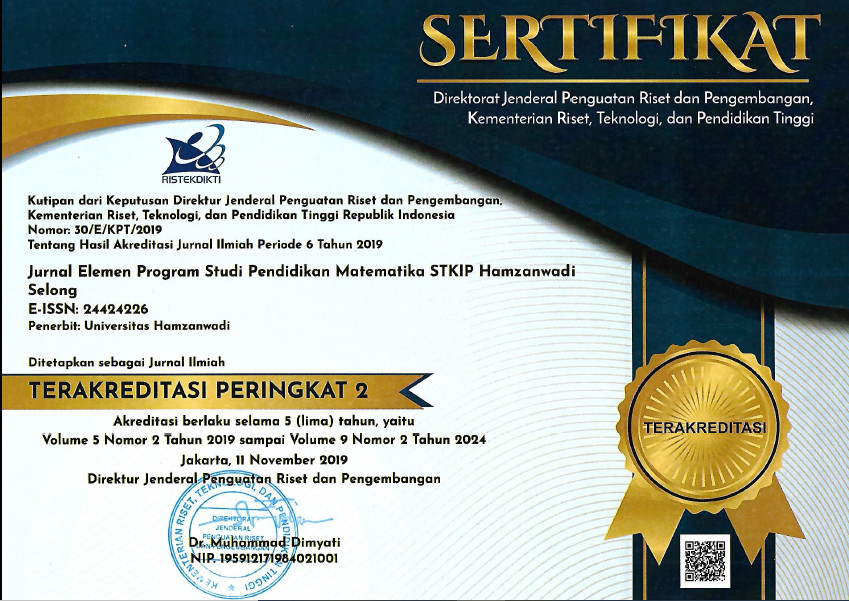Creative Problem Solving: Bagaimana Pengaruhnya terhadap Kreativitas Siswa?
DOI:
https://doi.org/10.29408/jel.v3i1.340Keywords:
creativity, creativity solve the mathematic problem and creative problem solving modelAbstract
This study aims to determine how the students' creativity in solving math problems in class X if given the problems that are non-routine. This type of research is using qualitative approach. Subjects in this study were selected three students of 22 male students of class X is based on tests of mathematical ability. Data is collected in the form of two different time solving tests and interviews. Data were analyzed using three steps, namely data reduction, the data display and conclusion drawing. Based on data analysis, found that the learning model creative problem solving can improve students' creativity in the form of an increase in problem-solving ideas are included in the components of fluency. In addition, given the increased student solutions differ from other research subjects are included in the components of originality. However, for component flexibility, only able to provide a variety of different ways to solve the problem, although it has not achieved until the end of the settlement proper.References
Arikunto, Suharismi. (2013). Dasar-Dasar Evaluasi Pendidikan. Jakarta: PT Bumi Aksara.
Hamalik, Oemar. (2002). Perencanaan Pengajaran Berdasarkan Pendekatan Sistem. Jakarta: PT Bumi Aksara.
Huda, Miftahul. (2013). Model-Model Pengajaran dan Pembelajaran Isu-Isu Metodis dan Paradigmatis. Yogyakarta: Pustaka Pelajar.
Kwon, NO., Park, JS., and Park JH. (2006). “Cultivating Divergent Thinking in Mathematics Through an Open-Ended Approachâ€, Asia Pacific Education Review. No. 1, th VII. Korea: Education Research Institute.
Moeleong, J. Lexy. (2012). Metodologi Penelitian Kualitatif. Bandung: PT Remaja Rosdakarya.
Mulyasa. (2011). Menjadi Guru Profesional: Menciptakan Pembelajaran Kreatif dan Menyenangkan. Bandung: PT Remaja Rosdakarya.
Muslich, Masnur. (2009). KTSP Pembelajaran Berbasis Kompetensi dan Kontekstual. Jakarta: PT Bumi Aksara.
Nasution. (2011). Berbagai Pendekatan dalam Proses Belajar Mengajar. Jakarta: PT Bumi Aksara.
Shoimin, Aris. (2014). 68 Model Pembelajaran Inovatif dalam Kurikulum 2013. Yogyakarta: Ar-Ruzz Media.
Siswono, Tatag Yuli Eko. (2008). Model Pembelajaran Matematika Berbasis Pengajuan dan Pemecahan Masalah Untuk Meningkatkan Kemampuan Berpikir Kreatif. Surabaya: Unesa University Press.
Sugiyono. (2014). Metode Penelitian Kuantitatif Kualitatif dan R & D. Bandung: Alfabeta.
Susanto, Ahmad. (2013). Teori Belajar Dan Pembelajaran di Sekolah Dasar. Jakarta: Kencana Prenada Media Group.
Suryosubroto. (2009). Proses Belajar Mengajar di Sekolah. Jakarta: PT Rineka Cipta.
Downloads
Published
How to Cite
Issue
Section
License
Authors who publish with the Jurnal Elemen agree to the following terms:
- Authors retain copyright and grant the journal right of first publication with the work simultaneously licensed under Creative Commons Attribution-ShareAlike 4.0 International License (CC BY-SA 4.0).
- Authors are able to enter into separate, additional contractual arrangements for the distribution of the journal's published version of the work (e.g., post it to an institutional repository or publish it in a book), with an acknowledgment of its initial publication in this journal.
- Authors are permitted and encouraged to post their work online (e.g., in institutional repositories or on their website) prior to and during the submission process, as it can lead to productive exchanges, as well as earlier and greater citation of published work.
Jurnal Elemen is licensed under a Creative Commons Attribution-ShareAlike 4.0 International License






